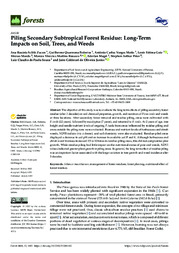Piling secondary subtropical forest residue: long-term impacts on soil, trees, and weeds.
Piling secondary subtropical forest residue: long-term impacts on soil, trees, and weeds.
Author(s): ZUCON, A. R. S.; PEDREIRA, G. Q.; MOTTA, A. C. V.; GOTZ, L. F.; MAEDA, S.; BASSACO, M. V. M.; MAGRI, E.; PRIOR, S. A.; SOUZA, L. C. de P.; OLIVEIRA JUNIOR, J. C. de
Summary: Abstract. The objective of this study was to evaluate the long-term effects of piling secondary forest residue (after 3 decades) on soil chemical properties, growth, and nutrition of Pinus taeda and weeds at three locations. After secondary forest removal and residue piling, areas were cultivated with P. taeda (22 years), followed by eucalyptus (7 years), and returned to P. taeda. At 2 years of age, tree height and needle-nutrient levels of ongoing P. taeda from areas influenced by residue piling and areas outside the piling zone were evaluated. Biomass and nutrient levels of herbaceous and shrub weeds, NDVI indices (via a drone), and soil chemistry were also evaluated. Residue-piled areas displayed a decrease in soil pH and an increase in available soil P and K. Although herbaceous and shrub-weed biomass increased 2.5 to 10 times in residue-piling areas, this did not compromise pine growth. While residue piling had little impact on the nutritional status of pine and weeds, NDVI values indicated greater plant growth in piling areas. In general, the long-term effect of residue piling was an important factor associated with the large variation in tree growth and weed incidence after 3 decades.
Publication year: 2022
Types of publication: Journal article
Unit: Embrapa Forestry
Observation
Some of Embrapa's publications are published as ePub files. To read them, use or download one of the following free software options to your computer or mobile device. Android: Google Play Books; IOS: iBooks; Windows and Linux: Calibre.
Access other publications
Access the Agricultural Research Database (BDPA) to consult Embrapa's full library collection and records.
Visit Embrapa Bookstore to purchase books and other publications sold by Embrapa.

